Emergency Responders, Blue Jay Style
Looking out for one another comes more naturally to some species than others.
(Listen to the radio version here.)
My dad was a Chicago firefighter who had to work 24-hour shifts every three days, unlike everybody else’s dad that I knew. Fires and many other emergencies are predictably unpredictable in the same way that I may know that migrating hawks will buzz and even grab birds in my yard every fall, but I never know exactly when. In the case of fire, our culture entrusts fire departments with responding instantly when needed even if much of the rest of their time firefighters are just eating, sleeping, learning musical instruments, playing cards, reading, watching movies and television, and otherwise having fun.
Of course, none of the fun stuff starts until all the equipment is clean and ready for the next emergency, and some of a firefighter’s duties when not on an emergency call involve preventing emergencies in the first place. On Sunday, while I was leading a birding trip at Park Point, two firefighters were at the recreation building changing the yellow warning flag about beach conditions to green, letting people know the somewhat dangerous waves of the day before were safer now. Firefighters also help set and enforce building codes to minimize fire dangers and provide fire safety education, such as issuing reminders every October to check our smoke detectors. They also help monitor controlled burns.
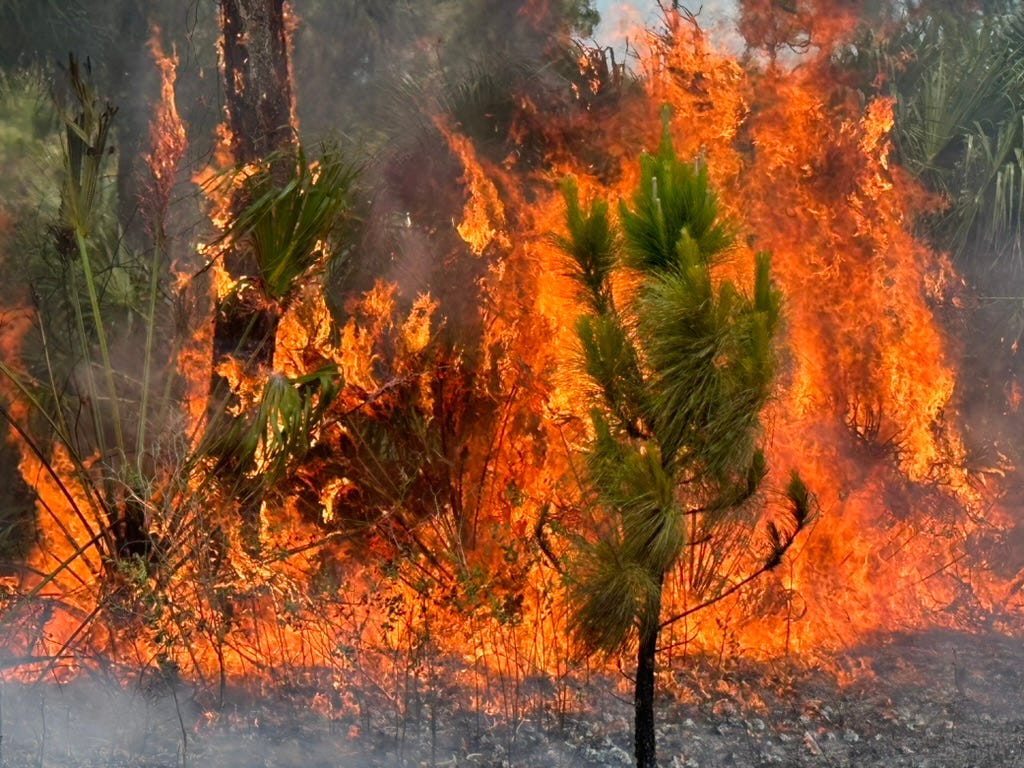
Fires can spread and quickly burst out of control, and so during the 1700–1800s, when most city buildings and even sidewalks were constructed of wood and other highly flammable materials, cities started providing firefighting services. The Chicago Fire Department did its best to fight the 1871 Great Chicago Fire, but their 185 firefighters with just 17 horse-drawn steam pumpers serving an entire city weren’t enough, especially because one watchman accidentally sent firefighters to the wrong place and an alarm sent from the area near the fire didn’t register at the courthouse where other fire watchmen were. This all happened during a hot, dry spell when firefighters were tired from having fought numerous small fires and one large fire the week before.
In the aftermath of the horrible blaze, the city developed new building codes and built up the fire department to much higher standards. Whether firefighters average five or six fire calls during a 24-hour shift or none at all, they get paid as full-time workers out of our tax dollars, and people don’t begrudge them a penny. We think of this kind of emergency response system as not just a human innovation, but a fundamentally civilized thing.
I thought about emergency responders on Saturday afternoon while sitting on my patio watching Blue Jays. I live in one of the neighborhoods under Hawk Ridge Bird Observatory where, that very day, 2,092 migrating Blue Jays were being counted. My yard serves as a fast-food option for a lot of the jays passing through, a pleasant stopover for those who need a longer break from travel, and home for a couple of local families.
But Saturday was also a good day for hawks to migrate, including what I think is the most dangerous Blue Jay predator of all, the Sharp-shinned Hawk. Counters at the Ridge tallied 1,075 of those.

Sharp-shins are primarily bird hunters. They’re not nearly as speedy as falcons, so they’ve mastered the element of surprise, flying into a stand of trees or an active bird-feeding station seemingly out of nowhere and grabbing whichever bird comes closest when they scatter in a panic. Sharpies don’t pursue a single bird for long—I’ve watched them chase warblers, sparrows, and jays for a short distance, but they usually seem to quickly give up and try another again somewhere else.
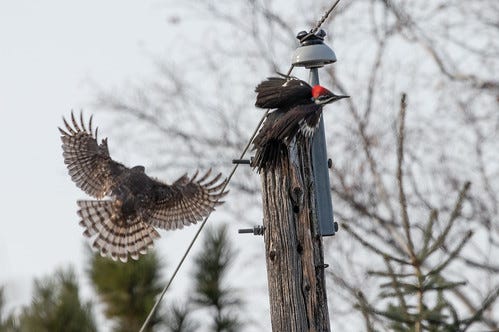
Sharpies can manage prey from hummingbirds to Pileated Woodpeckers, but focus mainly on ones in the middle of that size range. I suspect Blue Jays are one of their favorite menu items—slow fliers, easily manageable size, and providing way more protein than a measly warbler or sparrow.
A bazillion Blue Jays must have made my yard extremely tempting for one Sharp-shinned Hawk. The jays were feeding and occasionally calling, and I was enjoying this little peaceable kingdom until I suddenly heard it—the raspy jay call that I’ve learned to associate with a jay’s warning of a Sharp-shinned Hawk. The raptor made a couple of dives at the feeder, the jays scattering, but instead of moving on, the Sharpie ducked into some trees to try again.
This is exactly the kind of situation that makes me appreciate how human-like in intelligence and social interactions and how fundamentally civilized jays are. My feeders and trees were providing exactly the kind of food they wanted, but it was too dangerous to sit at a feeder when a sharpie could pop out from anywhere to grab somebody. So some of the jays kept track of exactly where the hawk was hiding out, intermittently making that unique raspy call to let everyone know where the hawk was and that the situation was under control. Dozens of jays returned to the feeders, pigging out safely, and whenever the hawk darted out, the jays taking charge yelled out their raspy warning and dive-bombed the hawk, slowing it down enough that everyone could elude it. A couple of times the hawk tried to grab one of the jays trying to divert it, but every time I saw this happen, other jays in the squad attacked hard while the pursued jay managed to maneuver away. The jays serving as the emergency response team kept their focus on the hawk so the others could mostly eat and rest.
I saw one very close call on the dead-end street next to my yard, but that jay tricked the hawk by flying straight toward my fence and twisting in flight at the last second. The hawk barely missed colliding with the fence and then turned tail and went back into the trees.
This went on for about 45 minutes, and at every moment, I knew exactly where the hawk was because the emergency responders were keeping track so everyone else could keep eating.
I watched a similar jay-sharpie interaction in 1995 when I staying at a cabin in Meadowlands. (I wrote about it at the time.) I’d parked myself in a pleasant spot ostensibly to work but got distracted by a large gathering of Blue Jays pigging out on acorns in a stand of oaks in the presence of one very determined Sharp-shinned Hawk.
From my vantage point that day, I could actually watch “the changing of the guard,” as jays took turns serving as sentinels and first responders or as acorn-diners. This Saturday I was too close to the trees in my own yard to get a wide enough view to see birds switch off, but I presume they did. Sharing enjoyable, sociable meals and fulfilling the responsibilities necessary to keep everyone safe seem to both be straightforward components of the Blue Jay social contract.
Firefighters and other human first responders need a union to ensure that no one works an unfair number of hours and that everyone gets fairly compensated. This time of year, Blue Jay communities are fluid, various migrants coming and going, yet they all seem to step up and share the responsibilities and benefits of community life equitably, no legal enforcement needed.
Our species has to work hard to maintain even a veneer of civilization. I wish we were innately civilized, like Blue Jays.


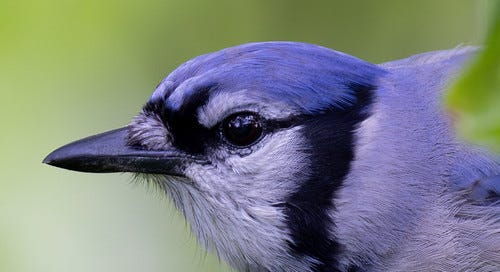



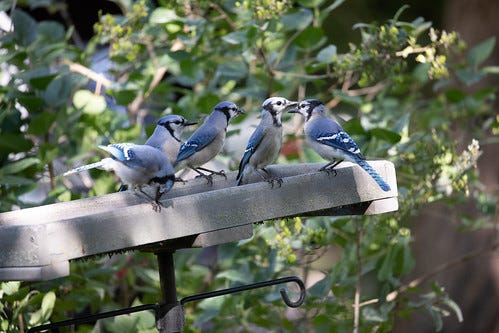
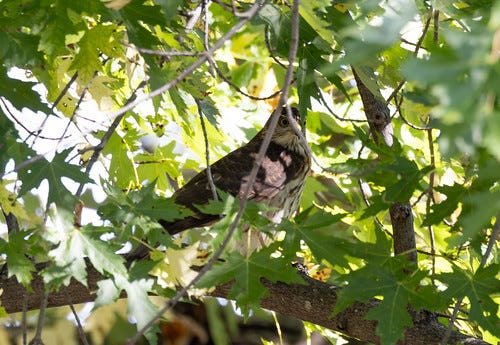
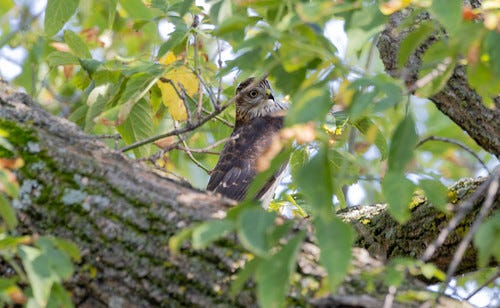
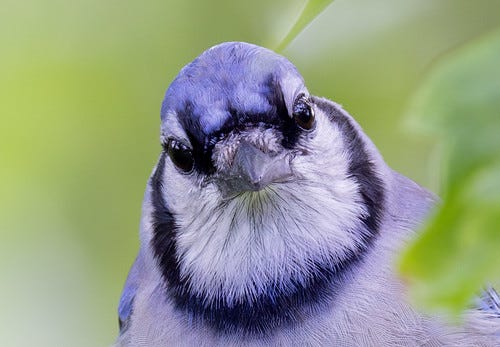
Recently across the street two American Crows mobbed a pair of Cooper’s Hawks. They paused and went out for reinforcements. They came back with 3 others and a Blue Jay, all commencing until a little later they seemed to realize they were having no effect, lost interest, and abandoned the Hawks to looking a little bewildered about the whole thing. I'm antropomorphizing, of course.